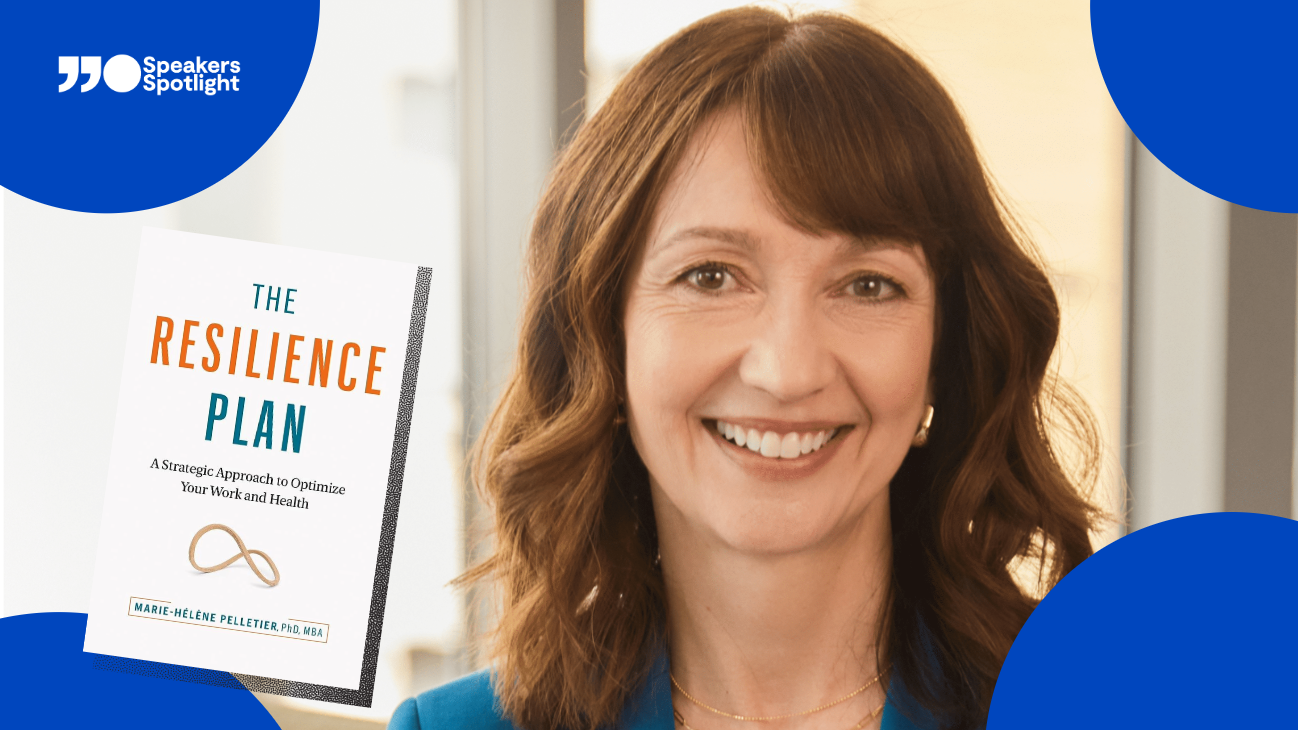Building resiliency is not a one-size-fits-all process. Our individual needs and contexts must inform our resiliency plan, or we’re setting ourselves up for burnout.

Dr. Marie-Hélène Pelletier combines her vast expertise in work psychology, workplace mental health, and leadership to share the art of crafting resilience strategically in her new book, The Resilience Plan. Resilience is not an innate character trait. Marie-Hélène shows readers how to proactively build and nurture it within themselves so they can draw from this place of strength when they need it most.
With resilience being the best defense to burnout, Marie-Hélène includes practical exercises throughout her book to help her readers build a tailored, goal-oriented resilience strategy while equipping them with the knowledge to implement and sustain it.
Marie-Hélène’s new keynote, “Resilience by Design: Mastering the Art of Strategic Reinvention”, complements her new book. Packed with engaging stories, relatable examples, and hands-on tactics, it empowers audiences to take the driver’s seat in managing their well-being, showing them how to weave resilience into their daily work and personal lives, not just as a reactive measure, but as a proactive strategy.
We were intrigued by this custom approach to resilience-building, and sat down with Marie-Hélène to talk about her new book and how her approach is key to balancing performance and mental health.
Resilience By Design
Speakers Spotlight: You’re one of a few work psychologists to hold both a PhD and MBA. How did your unique background shape your perspective on resiliency and your book?
Dr. Marie-Hélène Pelletier: I know what it’s like to work in a demanding role with high expectations and even higher stakes.
As a practicing work psychologist in clinical, counselling, and workplace psychology and a trusted senior leader, I know that successful professionals are fabulous — and at risk. They have impressive credentials and experience. They can handle gruelling hours and exceed high expectations. They are undaunted by challenges and embrace opportunities for growth. But because of this, they often think they’re naturally resilient, and they’re not. They’re at risk of burnout.
I wrote this book to put information and power into the hands of professionals and leaders, but with one key differentiator. By the end of this book, readers will have a strategic, custom resilience plan created to fit the unique context of their lives and give them the edge they need at work and home.
SpSp: Why is a one-size-fits-all approach to resiliency ineffective? And how do you help individuals tailor their approach to resilience to meet their unique circumstances?
MHP: What most conversations about resilience miss is context. Every individual has a unique personal and professional situation.
In my book and accompanying keynote presentation, I suggest practical and efficient strategies for people to build resilience within the context of their lives, taking into account the time they have, the actual demands they’re facing, the activities they enjoy, and options for adapting their plan based on what is happening in their lives in the moment.
Implementing and Maintaining a Resiliency Plan
SpSp: Implementing a resiliency plan can be just as challenging as creating one. What advice do you give to help people effectively implement and maintain their strategies?
MHP: Execution is as important as the strategy itself, just like in business. You need a plan, and you need it to be personal to you and your context.
The essence of a solid resilience strategic plan is that you’ve designed it so you can actually integrate it within your daily lives and maintain it. This often means scaling the actions to a much smaller start and aligning them with the reality of your context. It’s better to have a realistic plan you can implement than an overly optimistic plan you can’t.
SpSp: Can you share a story that illustrates the practical application of your resilience-building concepts?
MHP: In my book, I share a story of my executive coaching client, Beth. As we worked together to build her custom resilience plan, I started by asking her how confident she was about what she had in place.
She said, “I’m a five out of ten.”
“What do you do to protect and build your resilience?” I asked.
“I exercise a few times a week when I can.”
“So, in the past week, how many times have you exercised?”
“The past few months have been exceptionally busy, so not much,” Beth explained. “But in general, probably two to three times per week. And I went for a massage last month.”
I’ve heard versions of this response many times, including from myself. The top trap professionals and leaders fall into is not having clarity on which actions are key to their mental well-being and not maintaining them in times of high demand.
Beth knew exercise is good for her and tried to walk about three days per week. But she doesn’t walk when it’s raining, or if she needs to work longer hours, or if a call keeps her at her desk a bit longer.
What Beth has is one action — not a plan. While this can be a good start and lead to some momentum, what she ultimately needs is a custom plan that accounts for the unexpected. If not, Beth runs the risk of just implementing this one action that is not necessarily optimized to produce the desired outcome. Her plan has to start with a goal and from there walk through specific and customized directions and actions that can realistically be implemented.
Resilience and the Future of Work
SpSp: As we continue navigating an ever-changing work landscape, how do you see the role of resilience evolving? Are there emerging trends or challenges people should be aware of in their resilience-building efforts?
Looking ahead is exactly where we have the most opportunity. There is still much to be done today in terms of mental health awareness, resilience training, leadership training, flexible work arrangements, etc. But when we look ahead at what’s coming, it emphasizes the need to strategically build resilience in individuals, teams, and organizations now so we can be prepared.
Three trends I’m watching:
- Artificial intelligence: AI continues to expand both in our work and personal lives. In the work context, this represents a demand and an opportunity for which resilience is required both for individual contributors and leaders. We know from research that there are actions we can take now that can help and bring results.
- Burnout: Burnout resides in the relationship between the individual and their workplace. Organizations are challenged to identify and mitigate sources of stress, such as unrealistic workloads, lack of control, or inadequate support, and to promote a culture that values work-life balance. Research points to strategic directions and actions to implement to respond both reactively and proactively. The workplace is a system and there are actions for all parts: the organizations, teams, and individuals.
- Agility, meaning, and psychological safety: As we’re seeing more frequent and significant changes, our success hinges on our ability to learn and adapt to meet new challenges, and our ability to inspire others to do the same. This new pace of change demands a new level of interconnection between teams and clients, with an even deeper attention to meaning and psychological safety. You can become even more agile — and stay agile — when you build a strategy specific to your work context.
One of only a handful of work psychologists holding both a PhD and MBA, Dr. Marie-Hélène Pelletier expertly blends business acumen with the latest psychology research to provide audiences with actionable strategies to boost performance, manage change, and build leadership and organizational resilience.
Fluently bilingual in both English and French, contact us to learn more about Marie-Hélène and how her expertise in resilience can help strengthen your teams.




